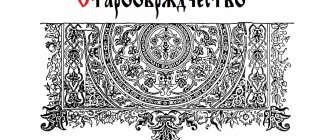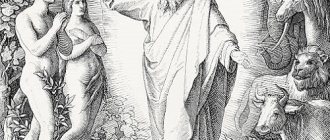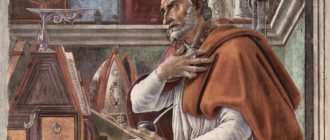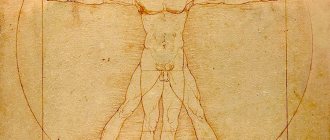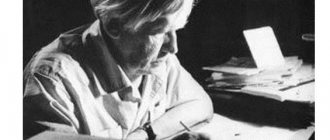CHRISTIANITY (Greek Χριστιανισμός, Latin Christianismus), the largest world religion, founded in the 1st century. Jesus Christ. It is represented by numerous (more than 20 thousand) denominations and sects, each of which claims to be the status of a true Church. The largest of them (2015): Catholicism (approx. 1.2 billion believers), various. denominations of Protestantism (approx. 800 million), Orthodoxy (approx. 280 million), ancient Eastern churches (anti-Chalcedonites; see art. Chalcedonites) and the Assyrian Church of the East (70–80 million believers).
Story. The Beginning of Christianity
"The Descent of the Holy Spirit on the Apostles." Mosaic fragment. Beginning of the 11th century Monastery of Osias Loukas (Greece).
(1st century) occurred in line with the prophecies of the Bible about the coming of the Messiah. Initially, the preaching of Christ and the apostles was carried out in Judea and neighboring regions and was addressed to the Jews, but later it turned to all nations. After the Resurrection of Christ (c. 33), a single community of believers arose - the Church (see Art. Pentecost). Paul and other apostles preached the Gospel among the Greco-Roman population of Syria (in the capital of which, Antioch, the term “Christian” arose), Asia Minor, Greece and Rome. The Council of Jerusalem (c. 50) freed non-Jewish Christians from observing the norms of Judaism. Closely connected with the Jewish diaspora, early Christianity subsequently, especially after the destruction of the Second Temple of Jerusalem (70), became isolated from Judaism; at the same time, the Old Testament remained part of the Holy Scriptures.
Emergence
The creation and development of a new world religion has a complicated history. The emergence of Christianity is shrouded in secrets, legends, assumptions and assumptions. Not much is known about the establishment of this doctrine, which today is professed by a quarter of the world's population (about 1.5 billion people). This can be explained by the fact that in Christianity, much more clearly than in Buddhism or Islam, there is a supernatural principle, belief in which usually gives rise to not only reverence, but also skepticism. Therefore, the history of the issue was subject to significant falsification by various ideologists.
In addition, the emergence of Christianity and its spread was explosive. The process was accompanied by active religious, ideological and political struggle, which significantly distorted the historical truth. Disputes on this issue continue to this day.
Spread of Christianity
(1st – early 4th centuries) to Rome. empire took place under legislative conditions. ban imposed on followers of the doctrine no later than the end. 1st century For refusal to participate in the official religious in cults, Christians were accused of “atheism” and insulting the state; the secrecy of their meetings gave rise to rumors about the extreme immorality of the teaching. During this period there were persecutions of Christians, the largest during the reigns of the emperors Valerian (253–260), Diocletian and Galerius (293–311). But mass executions for beliefs aroused sympathy, and the courageous behavior of the martyrs aroused respect for X. Days of remembrance for victims of persecution gave rise to the tradition of venerating saints (see Art. Canonization). At this time, the formation of Christian worship took place, the formation of 3 degrees of priesthood (deacon, presbyter, bishop) and local church organization (see Diocese, Church Councils). Christian literature emerges: early Christian apologists refute the accusations against X., and dogmatics develops in polemics against Gnosticism and other heresies. X. spread throughout Rome. empire, as well as in the buffer states of the Roman-Iranian borderland, in one of which (Osroene) it even received official status. religion (202). 301 traditionally refers to the adoption of X. in Armenia.
Why is the Church of Jerusalem not in first place in the diptych?
In the list of Autocephalous Local Churches, the Jerusalem Church is in fourth place. What is the reason for this? After all, everyone knows who was the first to accept Christianity - Christians in the world appeared in Palestine.
In 66, there was an uprising of the Jewish people against the power of the Roman Empire. As a result of the siege and storming of Jerusalem, the capital of Israel was razed to the ground. Many Jews died, and those who remained were scattered throughout the world. Due to tragic historical reasons, the Church of Jerusalem lost its unofficial primacy, losing it to Rome, the capital of the empire.
Since the 4th century, a gradual revival of the Jerusalem Church began. It was associated with the activities of the Byzantine emperor Constantine I and his mother Helen. In 451, at the Fourth Ecumenical Council, the Bishop of Jerusalem received the title of patriarch. Thus, the Church of Jerusalem again took its place in the Ecumenical diptych, but in fifth place, behind the Roman, Constantinople, Alexandria and Antioch Churches. This list of Churches establishes a certain sequence of standing at the altar during joint services. In 1054, the Roman Church left the family of Orthodox Churches. From that moment on, the Church of Jerusalem occupies 4th place in the diptych.
“The Jerusalem Church historically takes precedence in the family of Local Orthodox Churches, because it was in Jerusalem that the Lord Jesus Christ suffered and died on the Cross, in Jerusalem He was resurrected, and it was the Jerusalem community of the apostles that witnessed the Resurrection of Christ. No one will ever take away this historical primacy from the Church of Jerusalem” (Metropolitan Hilarion of Volokolamsk).
The era of the Ecumenical Councils
(4th–9th centuries, see Ecumenical Councils) originates from the appeal of the emperor. Constantine the Great (312) and the publication of the Edict of Milan (313), which removed all restrictions from X. In legal terms freedom and patronage from the emperors of X. became the main thing, and from the end. 4th century and the only official religion Rome. empires. The construction of temples is underway, pilgrimage and veneration of relics and relics are developing. The underlying distinction between the worldly and spiritual principles led to the formation of the so-called system. symphonies of authorities: the state and the Church act as independent institutions established by God, ensuring the material and spiritual well-being of society. Church-wide norms, both doctrinal (dogmas) and disciplinary (canons), are established at councils of bishops. But their maintenance is entrusted to the imp. power, which in special cases initiates imperial-wide Ecumenical Councils, the first of which took place in 325, and the last, 7th, in 787 (finally approved in 843). During discussions on issues of triadology (the doctrine of the Holy Trinity) and Christology, a galaxy of authoritative writers (holy fathers) emerged, whose opinions determined the direction of theological thought. Teachings rejected by church tradition are condemned as heretical, their leaders and adherents are subject to anathema and exile. The establishment of a clear distinction between orthodoxy (correct opinion) and heresy often took painful forms and caused opposition movements to fall away from the official (“Catholic”, “Orthodox”) religion. Arianism in the 4th–7th centuries. spread among the Germans. peoples (Goths, Vandals, Lombards); Nestorianism in the 5th–7th centuries. gradually took root in the Syriac-speaking Church of the East in Iran; Monophysitism in the 5th–6th centuries. became popular among Westerners. Syrians, Copts, Armenians and Ethiopians. During the conciliar, or patristic, period, monasticism arose and rapidly developed. The church administration was formed. structure and system of 5 patriarchates. Missionary work continues. X. spread among the “barbarian” peoples of the West. Europe (Ireland, England, Germany), took root in Aksum (4th century), Nubia (6th century), Georgia and Caucasus. Albania (4th century), reached India and China. To the beginning 7th century X., despite the internal division, dominates among world religions. But the situation changes dramatically with the advent of Islam.
The Jerusalem Church is the first in the world
The Jerusalem Church is the cradle of Christianity, the mother of all Churches. It preserves the treasures of the Holy Land, sacred to Christianity, associated with the life of the Savior, His Teaching and the redemption of the world. The first bishop and organizer of the Jerusalem Church was the Apostle James, the brother of the Lord according to the flesh (died in 62 or 69).
On the canonical territory of the Jerusalem Church there are such great shrines as Golgotha (the site of the crucifixion of Jesus Christ) and the Holy Sepulcher. The monasteries of the Jerusalem Church are known throughout the Christian world. Monastery of the Holy Sepulcher with the Church of the Resurrection of Christ. Bethlehem Monastery with the cave where the God-Man was born. Jordan Monastery of John the Baptist, located next to the supposed site of the Baptism of Jesus. Lavra of Saint Sava the Consecrated in the Judean desert. The Jerusalem liturgical charter, which is still used in worship today, was created here. Sinai Monastery of St. Catherine with the Burning Bush bush.
Participants in the Ecumenical Councils, Archbishop Cyril of Jerusalem (4th century) and Patriarch Juvenal of Jerusalem (5th century), the compiler of the Jerusalem Rule, the Venerable Savva the Sanctified (5th century), the church hymnist Saint Cosmas of Jerusalem (8th century) and many other saints belonged to the Church of Jerusalem.
Medieval period
(9th–15th centuries) is characterized by unrelenting pressure from the Muslims. peace and growing alienation between Christians in Western and Eastern Europe. Arab conquests 7th–8th centuries led to a decrease in the territory of the East. Roman Empire (Byzantium), Middle East, North. Africa and Spain fell under the rule of the Caliphate. Sharia law defines Islam as a revealed religion, “corrupted” by Christians, who are obliged to submit to Muslims, receiving protection under certain conditions (see Art. Zimmiah). In the West Europe against the backdrop of political degradation. institutions, the role of the papacy increased (see Pope), which began to lay claim to political power. power. Against this background, there was an ecclesiastical break between Rome and Constantinople (1054), aggravated by conflicts between Byzantium and participants in the Crusades, the fourth of which ended with the sack of Constantinople (1204). Attempts to conclude a church union (Lyon, 1274; Florence, 1439) did not lead to the resolution of dogmatic, ritual and other contradictions (for example, about the Filioque, celibacy, purgatory). European Christianity was divided into Latin (Catholic) and Greek (Orthodox), the latter's sphere included the countries of the East. Europe (except Poland, Czech Republic, Hungary and Croatia) and Rus' (see Baptism of Rus'). By the 15th century Most Orthodox states, including Byzantium (1453), came under the rule of the Ottoman Empire, and the role of leader of the Orthodox world passed to the Russian state. The doctrine “Moscow is the third Rome” arose. During the Renaissance, ideas of humanism, dating back to the language, spread in Europe. antiquity and in many respects alien to Christianity.
New time
(16th–19th centuries) was marked by a deep crisis in Western Christianity. Non-church religions. movements that had previously been suppressed through the Inquisition spun out of control and received national support. elite As a result, during the Reformation, the so-called. Protestants diff. interpretations (see Lutheranism, Calvinism, Anglican Church, Anabaptists). After the Counter-Reformation and religions. wars, Europe was split into Catholic and Protestant regions. This division was carried over to the colonial countries, primarily to the South. and Sev. America, where X. became the dominant religion. Secularization and the ideas of the Enlightenment contributed to the further weakening of traditions. religious institutions. Ideological movements appeared that openly broke with Christianity. De-Christianization in France (1790s) led to reprisals against clergy and destruction of religious buildings.
What are the sacraments
There is a unique concept in the Christian faith - sacrament. It arose as a definition of a special action that cannot be attributed to either rites or rituals. Only God can know the true essence of the sacrament; it is not accessible to man due to his imperfection and sinfulness.
The most important sacraments: baptism and communion. The first is the initiation of the believer, introducing him into the number of God-pleasing people. The second is connecting with the essence of Jesus by eating the sacred bread and wine, symbolizing his flesh and blood.
Orthodoxy and Catholicism recognize five more sacraments:
- anointing;
- ordination;
- repentance;
- marriage;
- Unction.
Protestantism denies the sacredness of these phenomena. This branch is also characterized by a gradual abandonment of asceticism, as the only way for a person to get closer to the divine essence.
Recent period
(20–21 centuries) is characterized by progressive de-Christianization. In Russia, since 1917, the process of de-Christianization took on a radical character and was accompanied by mass persecution (see New Martyrs) and active propaganda of atheism. However, it is in Russia that at the end. 20th century There has been a growth in H.'s influence in social and cultural life. Attempts to systematically respond to new challenges and overcome the disunity of Christians were ecumenism and the creation of the World Council of Churches (1961), the reform movement in Catholicism, the idea of a Pan-Orthodox Council in Orthodoxy and interfaith dialogues.


